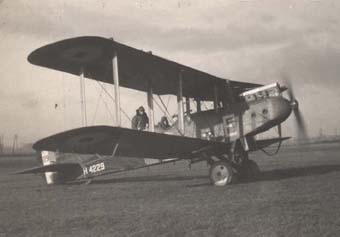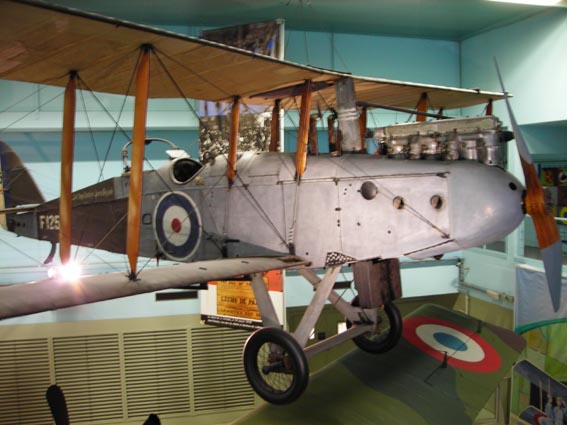![]()
103 Squadron RAF
1918
The Airco De Havilland DH9 Bomber
|
"...
out of date as a day bomber by June 1918" |
___________________________

DH9 of No 103 Squadron RAF 1918
The Airco DH9 was a modified version of the earlier DH4 bomber. Initially approved by the Air Board as part of efforts to create a long range bombing force, on the promise of similar performance to the DH4 but with longer range. However it became clear early on in production that the DH9 would have poorer performance. Originally it had been intended to fit an American supplied Liberty engine, but supply of these had been delayed through technical difficulties. Instead the DH9 would be fitted with the BHP 230 hp engine leaving it underpowered which, in Maj Gen Trenchard's view (as Commander of the RFC in France), would mean it would be outclassed by the enemy by mid 1918. The alternative of a Rolls Royce engine was not an option because of the limitations on production output and priorities for its use elsewhere.
According to the contemporary Jane's All the World's Aircraft the main alterations to the DH4 two-seater bomber were the move of the pilot's cockpit rearwards, just behind the trailing edge of the wing, making space for the internal carriage of bombs in the fuselage. The engine centre line was raised and the nose radiator replaced by a vertical water tank and a radiator in the bottom of the fuselage. In comparison to the DH4 the total empty weight was reduced by 100 lbs, the fuel tank size increased and the load carriage increased by 500 lbs, at the cost however of "a slight loss of speed and climb and an increase in the landing speed". Jane's might have added that the closing of the gap between pilot and observer would improve communication for fighting a machine under enemy attack. What Jane's also could not say at the time was that at full load, the service ceiling of the aircraft was about 14,000 ft some 2,000 ft lower than the DH4. In practice this meant that enemy fighters were able to reach the DH9 formations more easily. Added to this though was the unreliability of the engine in service which led to aircraft failing to reach their targets and sometimes to forced landings on the wrong side of the lines. Standard armament for the DH9 was a forward firing Vickers gun and a rear Lewis gun.
The DH9 appeared in action in France in April 1918 with No.s 206 and 98 Squadrons. Both Squadrons were engaged in bombing during the Battle on the Lys. DH9's progressively replaced DH4's in France and new Squadrons such as No 98 arrived with DH9's. Two DH9 Squadrons Nos 99 and 104 arrived in May 1918 as part of the creation in early June of the Independent Force, for operations against Germany.
For Maj Gen Trenchard, then commanding the Independent Force, the events of 31 July 1918 confirmed his early prejudices about the DH9. A formation from No 99 Squadron set out to bomb Mainz, three aircraft dropped out with engine trouble before crossing the lines, nine aircraft continued and because of enemy opposition attacked Saarbrucken. Four aircraft were brought down before reaching the target and of the five remaining, a further three were shot down. This one raid had resulted in the loss of 14 aircrew. By the end of August 1918 Maj Gen Trenchard had decided that the DH9's "could no longer be considered service type bombers and that the losses which must be expected they would suffer did not justify again sending them over the lines". (source: Official History of the War in the Air Vol VI)
Elsewhere the DH9 continued in service until the Armistice. Despite its limitations the DH9, flown in a tight defensive formation, could hold off attackers with some success and squadrons claimed a number of victories against attackers. The DH9 saw service in France with Nos 27, 49, 98, 99, 103, 104, 107, 108, 206, 211 and 218 Squadron. Some 2,166 DH9's were delivered for RAF service by the end of October 1918 and a total of 3,204 were produced.
|
Unflattering comparisons in performance between the DH4 and DH9 The Official History of the War in the Air makes particular reference to the performance of the DH4 and DH9 bombers during the Battle of Amiens, illustrating the poor performance of the newer aircraft. " The DH4 fitted with the 275 horse power Rolls Royce (Eagle VI) engine was splendidly reliable. In the four days of intensive fighting from 8-11 August inclusive the DH4's of 205 Squadron were in the air for a total of 324 hours 13 minutes, and dropped sixteen tons of bombs. Every aeroplane returned from its mission and no more than one had to be struck off the strength of the squadron." " By way of comparison, a typical DH9 squadron flew a total of 115 hours in the same period and dropped four and a half tons of bombs. During the operations seven of the DH9's were lost and two others were wrecked, and ten pilots had to leave formation without dropping their bombs, through engine trouble." "A further sidelight on the engine [Puma] question is .. that in the same four days pilots of 205 Squadron required no more than a total of 3 1/2 hours in all on test flights while those of the DH9 squadron spent 21 hours in the air on similar duties."
|

DH9 displayed at the Le Bourget Aerospace Museum Paris
|
DH9 Aircraft statistics
Wingspan 42'
4", length 30' 6", height 11' 2''. |
Sources:
The Official
History of the War in the Air Volume VI, H A Jones
Jane's All
the World's
Aircraft
WW1 Photograph Newby collection © airwar1.org.uk
www.airwar1.org.uk
